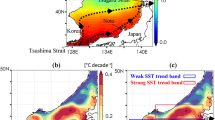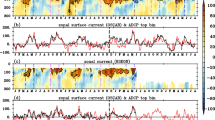Abstract
Based on hydrographic data obtained at an ice camp deployed in the Makarov Basin by the 4th Chinese Arctic Research Expedition in August of 2010, temporal variability of vertical heat flux in the upper ocean of the Makarov Basin is investigated together with its impacts on sea ice melt and evolution of heat content in the remnant of winter mixed layer (rWML). The upper ocean of the Makarov Basin under sea ice is vertically stratified. Oceanic heat flux from mixed layer (ML) to ice evolves in three stages as a response to air temperature changes, fluctuating from 12.4 W/m2 to the maximum 43.6 W/m2. The heat transferred upward from ML can support (0.7±0.3) cm/d ice melt rate on average, and daily variability of melt rate agrees well with the observed results. Downward heat flux from ML across the base of ML is much less, only 0.87 W/m2, due to enhanced stratification in the seasonal halocline under ML caused by sea ice melt, indicating that increasing solar heat entering summer ML is mainly used to melt sea ice, with a small proportion transferred downward and stored in the rWML. Heat flux from ML into rWML changes in two phases caused by abrupt air cooling with a day lag. Meanwhile, upward heat flux from Atlantic water (AW) across the base of rWML, even though obstructed by the cold halocline layer (CHL), reaches 0.18 W/m2 on average with no obvious changing pattern and is also trapped by the rWML. Upward heat flux from deep AW is higher than generally supposed value near 0, as the existence of rWML enlarges the temperature gradient between surface water and CHL. Acting as a reservoir of heat transferred from both ML and AW, the increasing heat content of rWML can delay the onset of sea ice freezing.
Similar content being viewed by others
References
Aagaard K, Coachman L K, Carmack E. 1981. On the halocline of the Arctic Ocean. Deep-Sea Research Part A: Oceanographic Research Papers, 28(6): 529–545
Comiso J C, Parkinson C L, Gersten R, et al. 2008. Accelerated decline in the Arctic sea ice cover. Geophysical Research Letters, 35(1): L01703
Dewey R, Muench R, Gunn J. 1999. Mixing and vertical heat flux estimates in the Arctic Eurasian Basin. Journal of Marine Systems, 21(1-4): 199–205
Fer I. 2009. Weak vertical diffusion allows maintenance of cold halocline in the central Arctic. Atmospheric and Oceanic Science Letters, 2(3): 148–152
Fowler C, Emery W J, Maslanik J. 2004. Satellite-derived evolution of Arctic sea ice age: October 1978 to Marc. 2003. IEEE Geoscience and Remote Sensing Letters, 1(2): 71–74
Kawaguchi Y, Hutchings J K, Kikuchi T, et al. 2012. Anomalous seaice reduction in the Eurasian Basin of the Arctic Ocean during summe. 2010. Polar Science, 6(1): 39–53
Krishfield R A, Perovich D K. 2005. Spatial and temporal variability of oceanic heat flux to the Arctic ice pack. Journal of Geophysical Research: Oceans (1978–2012), 110: C07021
Lei R B, Zhang Z H, Matero I, et al. 2012. Reflection and transmission of irradiance by snow and sea ice in the central Arctic Ocean in summe. 2010. Polar Research, 31(1). 1732.
Lindsay R W, Zhang J, Schweiger A, et al. 2009. Arctic sea ice retreat in 2007 follows thinning trend. Journal of Climate, 22(1): 165–176
Liu Y H, Key J R. 2014. Less winter cloud aids summer 2013 Arctic sea ice return from 2012 minimum. Environmental Research Letters, 9(4): 044002
Maykut G A, Untersteiner N. 1971. Some results from a time-dependent thermodynamic model of sea ice. Journal of Geophysical Research, 76(6): 1550–1575
Maykut G A. 1982. Large-scale heat exchange and ice production in the central Arctic. Journal of Geophysical Research: Oceans (1978–2012), 87(C10): 7971–7984
Maslanik J A, Fowler C, Stroeve J, et al. 2007. A younger, thinner Arctic ice cover: Increased potential for rapid, extensive sea-ice loss. Geophysical Research Letters, 34(24): L24501
Maslanik J, Stroeve J, Fowler C, et al. 2011. Distribution and trends in Arctic sea ice age through sprin. 2011. Geophysical Research Letters, 38(13): L13502
Maykut G A, McPhee M G. 1995. Solar heating of the Arctic mixed layer. Journal of Geophysical Research: Oceans (1978–2012), 100(C12): 24691–24703
McPhee M G. 1988. Analysis and prediction of short-term ice drift. Journal of Offshore Mechanics and Arctic Engineering, 110(1): 94–100
McPhee M G. 1992. Turbulent heat flux in the upper ocean under sea ice. Journal of Geophysical Research: Oceans (1978–2012), 97(C4): 5365–5379
McPhee M G. 2002. Turbulent stress at the ice/ocean interface and bottom surface hydraulic roughness during the SHEBA drift. Journal of Geophysical Research: Oceans (1978–2012), 107(C10): SHE 11-1–SHE 11-15
McPhee M G, Kikuchi T, Morison J H, et al. 2003. Ocean-to-ice heat flux at the North Pole environmental observatory. Geophysical Research Letters, 30(24): 2274
McPhee M G, Kottmeier C, Morison J H. 1999. Ocean heat flux in the central Weddell Sea during winter. Journal of Physical Oceanography, 29(6): 1166–1179
McPhee M G, Proshutinsky A, Morison J H, et al. 2009. Rapid change in freshwater content of the Arctic Ocean. Geophysical Research Letters, 36(10): L10602
Pacanowski R C, Philander S G H. 1981. Parameterization of vertical mixing in numerical models of tropical oceans. Journal of Physical Oceanography, 11(11): 1443–1451
Rudels B, anderson L G, Jones E P. 1996. Formation and evolution of the surface mixed layer and halocline of the Arctic Ocean. Journal of Geophysical Research: Oceans (1978–2012), 101(C4): 8807–8821
Sirevaag A, de La Rosa S, Fer I, et al. 2011. Mixing, heat fluxes and heat content evolution of the Arctic Ocean mixed layer. Ocean Science Discussions, 7: 335–349
Steele M, Boyd T. 1998. Retreat of the cold halocline layer in the Arctic Ocean. Journal of Geophysical Research: Oceans (1978–2012), 103(C5): 10419–10435
Steele M, Ermold W, Zhang J L. 2008. Arctic Ocean surface warming trends over the past 100 years. Geophysical Research Letters, 35(2): L02614
Stroeve J, Serreze M, Drobot S, et al. 2008. Arctic sea ice extent plummets i. 2007. Eos, Transactions American Geophysical Union, 89(2): 13–14
Thurnherr A M. 2008. How to process LADCP data with the LDEO software. version IX, 5
Author information
Authors and Affiliations
Corresponding author
Additional information
Foundation item: The Global Change Research Program of China under contract No. 2015CB953902; the National Natural Science Foundation of China under contract Nos 41330960 and 40976111.
Rights and permissions
About this article
Cite this article
Guo, G., Shi, J. & Jiao, Y. Temporal variability of vertical heat flux in the Makarov Basin during the ice camp observation in summer 2010. Acta Oceanol. Sin. 34, 118–125 (2015). https://doi.org/10.1007/s13131-015-0755-z
Received:
Accepted:
Published:
Issue Date:
DOI: https://doi.org/10.1007/s13131-015-0755-z




